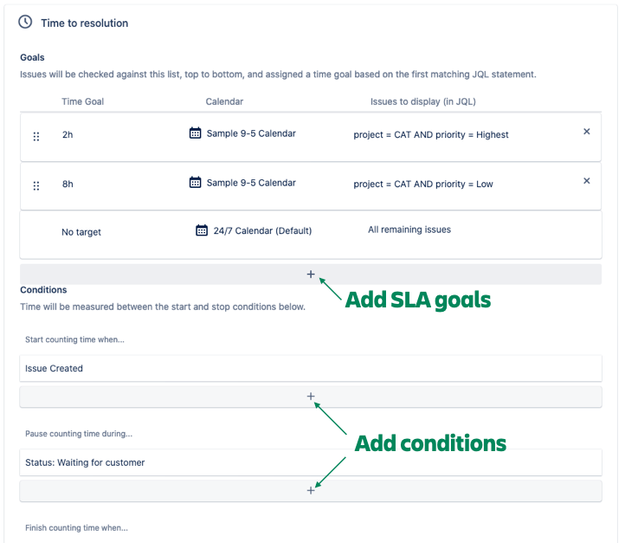Community resources
Community resources
Community resources
- Community
- Products
- Jira Service Management
- Articles
- Service level agreements get a facelift
Service level agreements get a facelift
Cloud SLAs have undergone a complete UI overhaul!
We've been busy building a lot of new features in the past month and we’ve also managed to squeeze in a treat for our admins. That's right! We've changed the service level agreements (SLAs) settings page.
If you're reading this and don't know what I'm talking about, here is a screenshot of the old SLA settings page.
Assuming you already familiar with the old page, let's go over what's new.
SLA collapsed view
We’ve fully reworked this view and it’s now easier to keep track of various SLAs.
On the top right, you’ll see two buttons to add SLAs or interact with calendars. Below that, you’ll see a description of what SLAs do in general and a list of your existing SLA settings.
This list includes one line item per SLA, specifying its name with buttons to edit, delete or expand each SLA.
SLA expanded view
If you want to drill down into any one of your configured SLAs, just click the chevron to the right to get an expanded view. Goals can be seen up top ordered based on their assessment. The start/pause/stop conditions can be seen below goals and they inform you when the timer starts ticking, what pauses it and when it stops.
SLA edit view
Editing SLAs is now a whole new experience. Add new goals and conditions by clicking on the "+" icon and filling in the goal details or selecting the condition for the timer.
To set up timer conditions, press the "+" icon in the Conditions section while in edit mode and select a value from the dropdown.
Calendars collapsed view
Moving forward, Calendars have a collapsed view which you can see by clicking on the calendar icon next to Add SLA in the top-right of the screen. Similar to SLAs, calendar entries are listed with their names and view/edit/delete controls.
Calendars expanded view
As with SLAs, calendars have an expanded view which will give you a complete perspective on how they are set up.
Calendars edit view
Lastly, editing calendars has been updated as well. The most notable change is the introduction of AM / PM time instead of 24hours time.
Looks amazing, I know! I'm thrilled that we can bring you this new user interface and make your service desk experience more delightful.
Before we get to the end of the article, I need to mention that you won't be able to access calendars if you don't have an active SLA and calendars can't be deleted if they belong to an SLA. So, in essence, you would need to have an active SLA to interact with calendars and you would need to remove calendars from SLAs before deleting them. This makes sense in practice and ensures that you're making deliberate changes to your SLAs.
Always remember to be kind to your SLAs as changing metrics will recalculate the SLAs associated with them. This is a costly task depending on the volume of issues involved. This means that it’s always best to make sure you have a good idea of what the SLA should look like before you start setting it up.
Let us know what you think about this new experience. Feel free to leave your questions, if any, in the comments section below!
Was this helpful?
Thanks!
Radu

Atlassian Community Events
- FAQ
- Community Guidelines
- About
- Privacy policy
- Notice at Collection
- Terms of use
- © 2025 Atlassian













30 comments